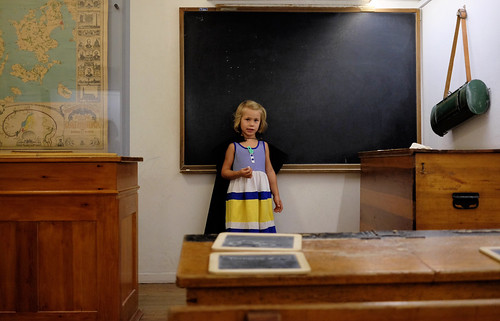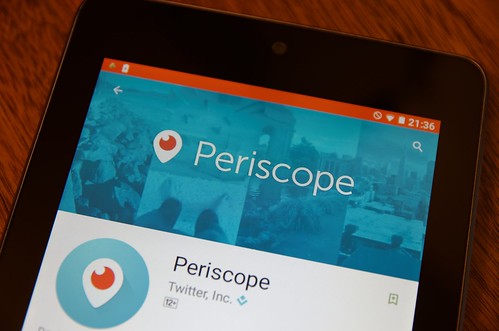A teacher I admire very much would always sign the letters she would send home to parents preceded by Yours in Education. I absolutely loved this and – just like any other teacher would – I borrowed it (with permission!) to precede my own signature on the various letters and permission slips I would send home. I just thought the idea was beautiful yet simple – it highlighted what I value most as a teacher and it demonstrated where my focus always lies: in education.
But the educational landscape is forever changing, being influenced both by internal and external factors, and its definition is continually evolving to meet the needs of the new environment and learners that are found within it. Although I have only been teaching for five years, within these five years of experience and additional five years of undergraduate education, I have seen cultural and social shifts in and around the educational field, particularly in regards to technology.
Postman wrote “…We now know that “Sesame Street” encourages children to love school only if school is like “Sesame Street.” Which is to say, we now know that “Sesame Street” undermines what the traditional idea of schooling represents“. What could this imply for the world of education? Sesame Street has been on tv for over 40 years and has garnered good reviews on Common Sense Media – a site that rates television shows according to their positive messages, violence and scariness, sexy stuff, language, consumerism, and drinking, drugs and smoking. Although it has been plagued with scandals in the past, Sesame Street has been known as an educational show, teaching literacy and numeracy as well as life lessons and skills. These things are learned through activities and interactions that are entertaining for kids – ones that can be simulated in traditional classrooms, but not always. Of course, it is understandable, that kids may expect school to emulate Sesame Street – and therefore be disappointed when it does not. Not only that, but the structure of school, the organisation of a prescribed curriculum, and the student behavioural expectations that are not necessarily represented in the “schooling” of Sesame Street – in addition to the six hours of continuous learning – can be a shock to students who expect differently due to their perceived notions of what school should be. This preconceived notion of what a classroom should look like, what someone should learn, and how they should learn can definitely undermine traditional (and current) school formats.
Although it can undermine what we know as education, I don’t necessarily think of this as a bad thing. It questions what we are doing and gives us the opportunity to critically analyze how we function and what we can do to improve. Remaining static and unresponsive to our environment is worse than seeing the world around us and questioning how our schools are responding to the need of (and for) education.
That being said, I do believe what Postman is saying can relate to the current culture of smartphones and the push towards BYOD in the classroom. Technology is becoming interwoven in education. I know in my own classroom, Kahoots! have become a mainstay for revising concepts; Google Classroom is common for sharing work and assignments; and the school’s Chromebooks are often used for inquiry-based projects. The first two depend greatly on students’ devices and, consequently, the integration of consistent usage of smartphones in the classroom. I will often use YouTube videos to get the kids thinking about different concepts around the world, or to simply differentiate the teaching in the classroom. History channel documentaries, #thisdayinhistory videos, and BrainPOP all help to change my classroom environment and culture. I do not find myself at the front of the room, sharing my knowledge top-down to my students – which was mainly the way I learned before I graduated high school in 2007. Not only does it differentiate who (or what) is teaching the material, but letting the students explore these websites themselves and acquire the knowledge they find most appealing is a way to encourage them to take initiative for their own learning, and it places themselves in the middle rather than on the outskirts of their own education.

Photo Credit: Lars Plougmann Flickr via Compfight cc
However, I do sometimes wonder if this current array of AV technologies is questioning our educational environment in a good way. Of course, change is necessary for growth and evolution; if we always stayed the same, our education wouldn’t reflect the needs of our society. If we didn’t integrate tech in our classrooms, we would be doing a disservice to the students. That being said, how we integrate these apps and interactive educational shows, and why we integrate them can either have a positive or a negative impact on the format of schooling. We shouldn’t use educational shows as a school replacement; nor should we depend on these to meet all the outcomes in our curricula. They should enhance, not define, our teaching and our educational environment. These different tools can definitely engage students in a different way in the classroom, but they need to be used appropriately and under the right conditions so as to not negatively undermine school.
Therefore, personalized devices, tools like Periscope, apps, and interactive educational shows change the way we think of school. Traditional schooling has had a bad rep for being boring and teacher-centered (especially if you ask my older brothers). Undermining that kind of education isn’t necessarily a bad thing – it helps to bring about change and growth in our schools and think of school as more than simply a place to take notes while the teacher lectures. These tools can motivate, engage, and inspire students to question things themselves and grow independently as individuals in the classroom. School is still a place of knowledge and learning, but now it is also filled with live-streaming, engaging educational apps and tv shows, and the interactivity of online games intended for learning. These technological advancements have helped us look deeper into education and question what is good, what is bad, what needs changing, and what can be more engaging. However, we have to remain critical in what we use and how we use it, so these things don’t dominate the classroom for little educational value.
This is what education means to me, and it will continue to evolve and grow over time, as will my definition.
What are your thoughts on the evolution of personalized devices, apps, and educational shows? Is it undermining our educational system, or helping it develop into what it should be for all learners, teachers, and students alike? Let me know your thoughts!
Yours in education,
Elizabeth



Great in-depth post Elizabeth!
I think it depends on how you view the word undermine. The goal of educational apps, shows, videos, etc. is to both help students to learn, aide in teaching students, as well as to make a lot of money for the producer/creator. It is up to us, the teachers to determine if the app, show, or video is supporting student learning and then use it as a tool. There seem to be so many great tools out there that it isn’t always easy to decipher what is best to include in our teaching practices. The collaboration in this class, definitely is one way to rule out many of these educational tools and discover the ones that are most effective.
LikeLike
You are completely right; the way you see the word ‘undermine’ will have an impact on the analysis of the blog post this week. I am also grateful about the collaboration in this class! Thanks for the comment!
LikeLike
I enjoyed your post Liz!! With all of our technological advancements we do truly need to look at what is a positive and negative in our educational programs. It is also important to remain critical on how we use technology in our classrooms and make sure they are valuable educationally.
LikeLike
I love the “yours in education” piece. Also, this was an excellent post that detailed much of the craze around many of the new and popular apps.
Re: your final question – I guess my observation is that there continues to be the narrative that education *must* be entertaining. Even something like Kahoot (as you mention) is fun and kids really seem to enjoy it – well, at least the first 100 times that a teacher has used it in the classroom. But at the heart of an app like that, the pedagogy is not really that great. Kahoot wouldn’t be as effective as (say) more constructivist methodologies, but those are not only more difficult to plan, they are (often) less engaging for many students (especially if not planned well).
So, as something we should all consider – do these apps simply represent less-effective edu-tainment? Are we being sold silicon snake-oil by big companies?
Excellent post! Thanks for the thoughtful attack on this week’s blogging prompt.
LikeLike
Thanks for the comment Alec! You have made me look at Kahoot differently; and I also feel like I need to make every one of my lessons entertaining so the students are engaged. Perhaps it is because of the onslaught of new educational apps and technologies, or perhaps it is the way our society has evolved with all kinds of apps and computer games available for kids from a young age. It will be interesting to see how things will change in the future – if we continue like this or move into a more constructivist approach to educational apps and lesson planning.
Thanks again!
LikeLike
Great post Liz! I often wonder about the educational value of things like Kahoot as Alec has mentioned. It’s great that it’s fun and students are engaged, but what are they really getting out of it? I think we need to be mindful of this when we are trying to make things fun and engaging. Does fun and engagement always mean that they are learning what we are hoping they are?
I do believe that personal devices, apps and educational shows need to evolve with education and we need to evolve with it as well. This doesn’t mean that we throw these tools into our classroom just for the sake of throwing them into the classroom though. I don’t think that they are undermining our education system.
LikeLike
Thanks for the comment, Ashley! After your and Alec’s comments, I definitely started thinking differently about Kahoot – and all other educational apps – in the classroom. What are they bringing to the table and is this worth the time they are taking away from other opportunities? It is all about weighing the pros and cons and knowing what is best for the different educational contexts in which we find ourselves. Thanks again!
LikeLike